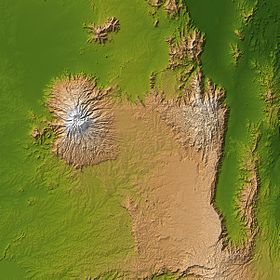Elgon
| Mount Elgon | |
|---|---|
| Wagagai (summit) | |

Mount Elgon (left) and Great Rift Valley (right)
|
|
| Highest point | |
| Elevation | 4,321 m (14,177 ft) Ranked 17th in Africa |
| Prominence | 2,458 m (8,064 ft) |
| Isolation | 339 km (211 mi) |
| Listing | Ultra |
| Coordinates | 01°07′06″N 34°31′30″E / 1.11833°N 34.52500°ECoordinates: 01°07′06″N 34°31′30″E / 1.11833°N 34.52500°E |
| Geography | |
|
|
|
| Topo map | Mount Elgon Map and Guide |
| Geology | |
| Age of rock | Miocene origin |
| Mountain type | Shield volcano |
| Last eruption | Unknown |
| Climbing | |
| First ascent | 1911 by Kmunke and Stigler |
| Easiest route | Scramble |
Mount Elgon is an extinct shield volcano on the border of Uganda and Kenya, north of Kisumu and west of Kitale. The mountain's highest point, named "Wagagai", is located entirely within Uganda. Although there is no verifiable evidence of its earliest volcanic activity, geologists estimate that Mount Elgon is at least 24 million years old, making it the oldest extinct volcano in East Africa.
Mount Elgon is a massive solitary volcanic mountain on the border of eastern Uganda and western Kenya. Its vast form, 80 kilometres (50 mi) in diameter, rises 3,070 metres (10,070 ft) above the surrounding plains. Its cooler heights offer respite for humans from the hot plains below, and its higher altitudes provide a refuge for flora and fauna.
Mt. Elgon consists of five major peaks:
Other features of note are:
The mountain soils are red laterite. The mountain is the catchment area for the several rivers such as the Suam River, which becomes the Turkwel downstream and drains into Lake Turkana, and the Nzoia River and the Lwakhakha River, which flow to Lake Victoria. The town of Kitale is in the foothills of the mountain. The area around the mountain is protected by two Mount Elgon National Parks, one on each side of the international border.
Some rare plants are found on the mountain, including Ardisiandra wettsteinii, Carduus afromontanus, Echinops hoehnelii, Ranunculus keniensis, and Romulea keniensis.
Mount Elgon and its tributaries are home to four tribes, the Bagisu, the Sapiinjak, the sabaot and the Ogiek, better known in the region under the derogatory umbrella term Ndorobo.
...
Wikipedia

